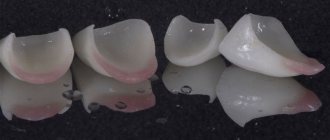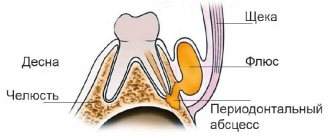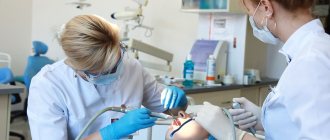In our time, implantology has achieved truly incredible success. Experienced surgeons are able to implant, at a time, not only one tooth root, but an entire row of teeth. Of course, such operations require highly qualified dentists. However, sometimes negative consequences occur after operations, and even during the operations themselves. Less commonly, they occur several years after the seemingly successful implantation of implants into the jawbone. For each such case there are reasons. In this article we will tell you about them.
Why might complications occur?
There may be several reasons for complications after implantation of artificial dental roots. Some of them relate to the mistakes of dentists, and some of them relate to the fault of the patients themselves.
Medical errors include the following:
- incorrect choice of implant length;
- overheating of bone tissue at the site of implant installation;
- insufficient disinfection of the patient’s oral cavity;
- incorrect choice of prosthesis design;
- an error in assessing the physiology of the patient’s body in terms of susceptibility to a foreign body;
- use of low-quality titanium implants;
- use of outdated surgical equipment;
- careless installation of the prosthesis on the root.
The following reasons should be attributed to the fault of the patients themselves:
- careless oral hygiene after implantation;
- the patient's inability to give up bad habits;
- eating solid food during the implant healing stage;
- Irregular use of medications recommended by the surgeon.
Signs of complications
Implantation is dangerous because complications can arise at very different periods, both immediately after the operation and many years later. According to the nature and period of manifestation, the consequences of dental implantation are divided into three groups: during surgery, in the early period (first months) and in the late period (after a year or more).
During surgery
Medical errors today are exceptional cases, but they still occur if the doctor does not have sufficient experience and professionalism.
During the operation, the following may occur:
- severe tissue injury and wound formation;
- injury to nearby organs.
The reason may be not only an incorrect action by the doctor, but also an error in choosing the size and shape of the implant.
In the early period
After dental implantation, both immediately and during the first months, signs of complications may occur:
- suture separation due to improper application or mechanical trauma;
- severe bleeding that does not stop throughout the day and is caused by damage to blood vessels;
- an increase in temperature of more than 38 °C that persists for more than a day.
Consequences in the early period can be caused by improper installation of implants, infection of internal tissues, rejection of implants by the body, or the development of an inflammatory process.
In the late period
Complications after implantation can occur at any time after prosthetics. This happens under the influence of various factors: from poor hygiene and excessive stress to dental or immune diseases. The consequences can appear after 2, 5 and even 10 years.
After a long period of time, complications are possible:
- peri-implantitis, characterized by inflammation of the tissue around the implant;
- implant rejection or loss;
- exposure of the implant due to improper installation of the gum former.
Our clinic cooperates with Nobel Biocare, which provides a lifetime guarantee on implants. Many years of successful practice, millions of clinical cases around the world allow the company to be on the list of the best. We give each of our patients a corresponding certificate.
Possible mistakes of surgeons
Negative consequences can occur even during careless operation. Let's name a few medical errors that, unfortunately, although rarely, happen.
Sometimes the doctor inadvertently overheats the head of the titanium root. This occurs due to overheating of the bur and hollow in the jaw bone. The reason for this is untimely irrigation of both.
If the doctor begins to tighten the implant screws while the cement is hardening, this ultimately leads to incorrect root installation, since the cement in this case cracks.
If the doctor does not place the head of the implant tightly in the hollow of the jaw bone, there is a risk of inflammation occurring, as bacteria enter the gap. In addition, loose placement of the head can lead to an imbalance of mechanical load on the entire prosthetic structure. This can cause peri-implantitis.
What is the cause of complications after implantation?
The main reason for all postoperative complications when installing an implant is its rejection by the body. The cause of this process can be both medical errors and the individual characteristics of the patient’s body.
To understand why the body may reject an implant, we need to look at how the human immune system works. The task of the immune system is to identify foreign elements (both organic and inorganic origin) that have entered the body and destroy them. When immune cells detect damage to a person’s integumentary tissue, they immediately begin the process of fighting infectious agents that enter the blood through the wound. Inflammation (redness, swelling, increased temperature) of wounds during healing is a consequence of the work of the immune system.
If, during healing, large (compared to bacteria) foreign inorganic objects are present in the wound (splinters, pieces of metal, wood, and even grains of sand), then the body, with the help of immune cells, will reject these objects, “pushing” them out of the wound. Unfortunately, dental implants embedded in the bone are also foreign objects to the body.
In order to reduce the risk of the body's immune response to the implant, bioinert materials are used for its manufacture. These are materials that are implanted into the body as quickly as possible, without causing protective reactions and inflammation and without changing metabolic processes in the tissues surrounding the implant. However, such materials can cause rejection for several reasons, such as:
- individual patient reaction to the implant material;
- an allergic reaction to the implant material or medications used for pain relief and disinfection of the implantation site;
- inflammation around the implant associated with an infectious process.
In addition to natural causes of implant rejection, there is also a risk of a doctor’s error or oversight during surgery:
- incorrectly chosen implant design;
- not removed inflamed tissue around the implantation site;
- low quality instruments and implants;
- violation of rules regarding the sterility of instruments and equipment during implantation;
- inattention to the patient (ignoring complaints, information about diseases, allergies).
But patients can also make a number of mistakes and actions that can lead to implant rejection:
- ignore the doctor’s advice on caring for the oral cavity and the implant, particularly in the postoperative period;
- do not observe the rules of dental and oral hygiene;
- violate or interrupt the course of medications prescribed by a doctor;
- receive jaw injuries that trigger the process of implant rejection.
Features of implantation in the upper jaw
The operation of implanting titanium roots into the upper jaw is always accompanied by considerable difficulties. This is due to the difficulty of access to the implant installation site and the close location of other organs. Often such operations are accompanied by complications. To make matters worse, the density of the maxillary tissue is lower than that of the mandibular bone. Because of this, it is necessary to drill a deep hole in the bone and install long implants. This can also cause postoperative complications.
During installation of the implant, the nasopalatine bundle, which is located in the center of the upper jaw behind the front teeth, may be injured. Such an injury causes prolonged bleeding, and this leads to the fact that the implant does not take root at all.
There is also a risk of damage to the sinuses and even nasal cavities. In both cases, sad complications are inevitable.
In case of damage to the neurovascular bundles located in the canine area, numbness of the upper lip occurs.
Dentistry knows cases where during implantation the integrity of the sinus floor was violated. This phenomenon leads to the occurrence of sinusitis.
There is also a risk of damage to the palatal artery, causing heavy bleeding.
All of the above may not happen if implantation is performed by experienced surgeons.
Implantation in the lower jaw
Installing artificial roots in the lower jaw is much easier. However, there are certain problems here too, since there are areas on the lower jaw that should never be disturbed.
If during the operation the surgeon disturbs the mandibular branch of the trigeminal nerve, then the patient’s oral cavity will completely lose sensitivity.
If the wall of the mandibular canal is damaged, numbness of the lower lip and part of the chin occurs.
Injury to the external branch of the facial artery generally leads to severe bleeding, and here one cannot do without the help of a surgeon.
Chewing upper teeth
How a tooth is implanted in the upper jaw depends on the individual characteristics of its structure. When it comes to chewing teeth, a two-step technique is often used. In this case, the permanent crown is fixed only after the artificial root has completely taken root in the bone tissue. This method is the most reliable and predictable.
Osteoplastic surgery is a stage that often precedes the implantation of chewing upper teeth. Most experts unanimously choose classic root-shaped structures as artificial roots.
Early complications
In the first days after implantation, the patient may experience pain, sometimes very severe. Often, the dentist even prescribes painkillers to patients, which should never be abused. If the pain does not disappear after a week, this indicates that there is inflammation or nerve damage.
About two hours after implantation, swelling occurs in the patient’s mouth, and this is quite normal. It may not go away for a week. At this time, it is allowed to apply ice to the swollen areas. If after a week the swelling has not subsided, then most likely there is tissue inflammation.
The patient's gums may bleed slightly for two to three days after surgery. Blood oozes at the site of the implanted root. If the bleeding is significant, the cause may be poor blood clotting or high blood pressure. If the bleeding continues, then most likely the surgeon damaged a blood vessel. This, in turn, can cause a hematoma to appear at the implant site. Because of this, postoperative sutures may come apart and the wound may begin to rot.
During the first week after implantation, the patient experiences an elevated body temperature. This is quite normal if the temperature does not exceed 37.5 degrees. If it is higher or does not subside after a week, this means that an inflammatory focus has formed in the oral cavity. This phenomenon is usually accompanied by swelling.
There are cases where in the very first days after surgery, patients’ sutures came apart. This happens due to their careless application, due to mechanical damage from solid food, or due to the onset of inflammation.
If within five hours after the operation there is numbness of the tissues near the oral cavity, then you should not be afraid of this, because the anesthesia has not yet completely worn off. If the numbness continues to persist, then the nerve may have been damaged during implantation.
The main signs of complications
Since complications can be of varying degrees of danger. But they are often difficult to recognize at an early stage; a person begins to confuse them with the normal course of the recovery process.
It is worth paying attention to the following potential signs of inflammation:
- Strong pain. If it turns out to be unbearable or does not go away within two or three days, you should consult a doctor.
- Temperature increase. During implantation, an increase in temperature above 38 °C becomes suspicious. If it lasts for a long time, there is a great danger of severe inflammation.
- Inflammatory process. It can manifest itself in pain, increased tissue temperature, and swelling.
- General poor condition of the patient. There is a high probability of severe weakness, fever, and decreased immunity in a person.
- Seam divergence. You can even notice it visually during personal inspection.
- Separation of foreign fluids from the wound. Blood or pus may leak.
- Neoplasms near the implantation area. These may be small hematomas, tumors, edema.
Signs also include a feeling of pressure and heaviness in the bridge of the nose, severe discomfort.
Late complications
Such complications can arise a year after the successful implantation of artificial roots and the installation of prostheses on them.
Peri-implantitis. Sometimes patients develop peri-implantitis after a year. In simple terms, this is inflammation of the bone tissue near the implant. Most often, the cause of its appearance is careless oral hygiene. Less commonly, the reason is a violation of the implant installation technology. In particular, there are known cases of damage to the gingival cuff and even the presence of cement in it.
It is possible to cure peri-implantitis with medication only at an early stage of its development. In this case, in any case, it is necessary to remove the prosthesis from the root and laser or ultrasonic cleaning of the implant itself. If tartar has formed in the oral cavity, then they must also be removed. Only after this are medications prescribed.
At a later stage of development of peri-implantitis, treatment is much more difficult. It is a complex of surgical and medical procedures. These include:
- ultrasonic sanitation of the oral cavity and gum pockets;
- opening the purulent focus and cleansing the tissue underneath;
- thorough disinfection of the implant;
- removal of dead tissue;
- prescribing a course of drug treatment.
The advanced stage of peri-implantitis cannot be treated. At this stage, the implant becomes mobile. In this case, it has to be removed from the jawbone. A new implant can be installed only after peri-implantitis is completely cured. Unfortunately, this is by no means a simple matter. Only 6 months after the cure of peri-implantitis is osteoplasty allowed, without which re-implantation of the titanium root in the same place is impossible.
Sinusitis. This complication manifests itself in the form of inflammation of the oral mucosa near the maxillary sinus. The treatment process does not require removal of the implant. Usually the problem is solved with drug treatment.
Mechanical damage. Complications due to mechanical damage arise solely through the fault of the patient when, in violation of the doctor’s recommendations, he became interested in eating too much solid food. In addition, mechanical damage to the structure can occur from malocclusion or bruxism. There are known cases where prostheses and even implants broke in such cases. It doesn't matter if the prosthesis breaks. It can be easily replaced. If the implant breaks, then its removal from the jawbone is required.
Negative consequences after surgery
Complications of the postoperative period are divided into early and late.
Symptoms of early complications in the postoperative period
- Painful sensations of varying intensity. They may accompany implantation and be observed for several days after it. It is recommended to take painkillers as prescribed by the doctor. Pain that does not go away for a long time may indicate the development of an inflammatory process or nerve damage .
- Swelling. It occurs a couple of hours after the intervention and is a consequence of damage to soft tissues. To eliminate swelling, apply ice to the gum. The presence of swelling within a week should not be a cause for concern. If the swelling does not subside or decrease after an acceptable period, then there is a high probability of tissue inflammation .
- Bleeding. Moderate gum bleeding at the implant site is acceptable. The symptom should disappear within a few days. The appearance of heavy bleeding during surgery may occur due to low blood clotting or increased blood pressure. Prolonged bleeding indicates vascular injury, which is fraught with the development hematoma. Hematomas slow down the healing process, provoke suppuration of the wound, and lead to sutures coming apart.
- Fever. Having a low-grade fever for 7 days is a normal reaction of the body. A temperature above 38 degrees that does not subside for a week, combined with swelling of the gums, are signs of an inflammatory process .
- Seams coming apart . Complications occur when sutures are placed poorly, mechanical damage, or inflammation at the site of the suture.
- Numbness is acceptable for 5 hours after implantation. If sensitivity is not restored after an acceptable time, there is a possibility of nerve damage .
- Inflammation of the soft tissues of the jaw.
Delayed complications during the functioning of dental implants
Late complications occur a year or more after implant placement. These include:
Peri-implantitis
Inflammation of the bone tissue around the implant, which occurs due to poor oral hygiene, violation of installation technique - injury to the gingival cuff, the presence of cement in it.
Treatment of peri-implantitis with medication is possible at the first stage of the disease . Carry out:
- administration of anesthesia, removal and cleaning of the prosthesis;
- removal of granulation from the surface of the implant using laser, ultrasound;
- removal of tartar;
- carrying out applications with medications;
- prescription of antibiotics.
The process , which is in its later stages , requires a combination of surgical and therapeutic treatment . Carry out:
- sanitation of the oral cavity and gum pockets with ultrasound;
- opening and cleansing of the purulent focus;
- treatment of the implant with antiseptic agents;
- removal of necrotic tissue;
- prescription of antibiotics.
If you see a doctor late, often the only treatment option is removal of the implant.
Re-implantation is carried out after complete cure of reimplantitis. In most cases, osteoplasty is first required, which is performed within six months after treatment.
Sinusitis
Inflammation of the mucous membrane of the paranasal sinuses. Occurs when an implant is installed near the maxillary sinus.
Mobility of the prosthesis indicates peri-implantitis and the need for urgent removal of the implant. Anti-inflammatory drugs are then prescribed.
If implant mobility is not diagnosed, then its removal is not required. Anti-inflammatory treatment is indicated.
Mechanical damage
Occur when the prosthesis is exposed to heavy loads . Appear in the presence of malocclusion, bruxism. They can cause a fracture of the prosthesis, the implant itself or its elements.
If the orthopedic parts of the implant are fractured, they are replaced. If the rod itself is broken, it is necessary to remove the part remaining in the jaw bone.
Fractures of dentures occur due to wear and tear of their parts. If the prosthesis is broken, it is repaired, and if the structure cannot be repaired, a new one is made.
Implant rejection
Occurs due to rejection of the structure by bone tissue. Requires implant removal.
The disease has the following stages of development :
- The first stage is characterized by inflammation of the tissues surrounding the implant. There is a noticeable increase in the pocket and thinning of the bone in the area of the prosthesis.
- At the second stage, the height of the bone changes, and gum detachment is noticeable.
- The height of the bone decreases, the pocket increases until the abutment is exposed, and mobility is observed.
- The last stage is characterized by destruction of the alveolar process and implant rejection.
Signs of implant rejection are:
- swelling of the gums at the implantation site and adjacent ones;
- soreness;
- discharge of pus;
- bleeding;
- enlargement of the gum pocket;
- mobility of the structure;
- elevated body temperature.
Non-survival of the implant
The phenomenon of implant rejection by bone tissue is extremely rare. There is only one way out of the situation - removal of the implants.
Implant rejection does not occur instantly, but in a certain sequence. Each stage of this phenomenon is accompanied by its own symptoms.
At the first stage of rejection, tissue inflammation occurs near the implant. This is followed by an enlargement of the pocket and thinning of the bone in the area of the implant.
In the second stage, the height of the jawbone around the implant noticeably decreases. At the same time, gum detachment occurs until the abutment is exposed. The implant becomes mobile.
The third and final stage is characterized by destruction of the alveolar process and rejection of the implant itself.
The beginning of the implant rejection process can be determined by the following signs:
- swelling of the gums in the area of the implant and next to it;
- general malaise;
- the appearance of pus in the oral cavity;
- the appearance of bleeding from the gums;
- enlargement of the gum pocket;
- implant mobility;
- increase in body temperature.
During operation
Late complications occur 6 months or more after implantation. Causes:
- violation by the patient of the rules of oral care;
- exacerbation of chronic diseases;
- errors by the implantologist in selecting the implantation protocol, violation of prosthetic technique;
- installation of low-quality implants;
- hormonal changes in women in the first six months after installation of implants (menopause, pregnancy).
The most common complications:
- Mucositis - manifests itself as redness, cyanosis or bleeding of the gums in the area where the intraosseous element is installed.
- Peri-implantitis is characterized by inflammation along the border between the implant and bone tissue, resorption (destruction) of the latter.
- Sinusitis - may be of rhinogenic origin, then the area of the artificial root becomes a secondary focus of infection.
- Inflammation of the maxillary sinus can develop against the background of peri-implantitis.
- Damage to the orthopedic structure - when chewing, loads regularly occur on the dentures and the implants themselves.
Similar articles:
- Guarantees of our Center
- Reasons for rejection
- Engraftment of implants
Safe complications
Even after an impeccably performed implantation, natural complications always occur, which are the body’s natural reaction to mechanical intervention. We list the complications that you do not need to be afraid of:
- body temperature up to 37.5 degrees;
- swelling of the face;
- feeling of heaviness in the maxillary sinus;
- minor hematomas;
- quite tolerable pain.
All these troubles can only be endured for a week. If they do not disappear further, then, most likely, something went wrong during the implant healing process.
Prevention of complications
Now that we have looked at what complications can occur after dental implantation, it is worth touching on another important topic - how to prevent their development. There are several universal tips:
- Always strictly consider what your doctor recommends for you. It is best to additionally write down everything said during the session so as not to get confused.
- Before undergoing implantation, make sure that you have no contraindications. It is especially important to understand whether your coagulation is normal, whether there is an inflammatory process in the body, or problems with blood pressure. It is also worth understanding the likelihood of allergies to anesthesia.
- Use only recommended medications. The doctor can prescribe anti-inflammatory medications, antiseptics and antibiotics.
- Pay close attention to your oral hygiene. It is very important to pay attention to what pastes, toothbrushes and other products you use.
- Pay attention to the use of compresses. They will help not only reduce swelling, but also reduce pain.
- Follow your diet and chew very carefully. It is worth giving up too hard, sour or salty foods during the rehabilitation period. Alcohol and smoking are also not recommended.
- Try to avoid physical activity. You should also not visit the sauna and overheat the tissues.
To reduce the likelihood of implant rejection, you need to handle the wound very carefully. Do not touch it with your tongue or finger - there is a high risk of contamination or infection.
How can complications be prevented?
Practice shows that by strictly following all doctor’s recommendations, you can significantly reduce the risk of complications. To do this you need:
- regularly take the medications prescribed by the doctor;
- carefully perform oral hygiene;
- quit smoking;
- undergo annual x-ray diagnostics of the oral cavity;
- stop eating solid food;
- strictly adhere to the postoperative diet.










